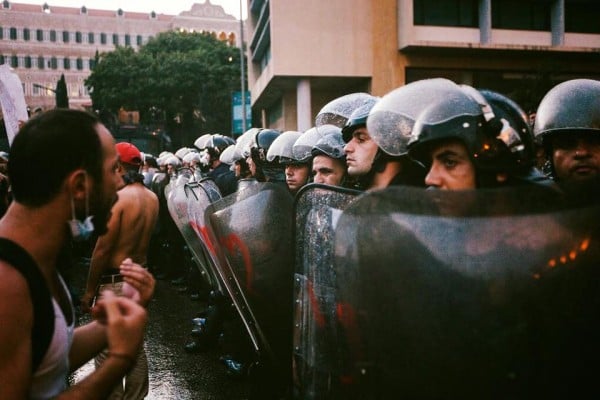 Picture: Karim Mostafa – www.karimphoto.com
Picture: Karim Mostafa – www.karimphoto.com
Lebanese youth have turned anger into action with the emergence of the You Stink campaign for political reform. Rewa Zeinati analyses the conflicting roles traditional and social media have played in the protests
Drive down any road in Lebanon and you notice cars go by, you spot a mountain (or seven), you turn your head and are stunned by the glittery breadth of the blue. You inhale the salty air, you turn up the music, you smile to yourself, you say ‘this is beautiful, this is what I love about this place, this is underrated and this is right where I want to be. This’.
Up until the moment someone in the car driving ahead of you decides to open her window and fling something out of it. It could be anything; tissue paper, an empty bag of chips, a soda can, even a beer bottle. Glass, so it breaks noisily on the pavement. Do I overstate? I wish. This is Lebanon, where your home is spotless but your street is fair game; a public trash disposal. How do you deal with that? You wait for the garbage truck at 5am to come and pick it up. To pick it all up. But what if you picked it up yourself? Better yet, what if you never threw it out to begin with and waited until you found a proper trash bin to drop it in? What if you pressed rewind and went back to start?
But this isn’t about the start. This is about moving forward. Lebanon is a country that holds around four million Lebanese, 19 different religious sects and an unknown number of Arab refugees from neighbouring countries. It suffers religious and political turmoil and fanaticism at its very edges, social and environmental troubles, and a whole lot of political corruption. The politicians in place are the warlords of the past civil war, openly treating the country like a giant company whose sole aim is monetary profit (for their pockets of course), and whose only means to stay in power is to keep the people divided through unswerving sectarian rhetoric. And hungry and reliant through bribery, debts and unemployment.
It is also a country where the tech-savvy youth are educated, creative and aware. And very, very tired of the political farce.
The straw that broke the camel’s back
So littering literally happens this time and no one picks it up. And it’s not because someone threw a can out of the car window. The piling trash in street corners all over the country – a result of political/business competition/corruption – was the last straw that went beyond the grievances over unemployment, power and water shortages, poverty, forced immigration, sectarianism, wasta, lack of accountability and perpetual humiliation.
So how did people react? They didn’t. The youth did. They got angry and they wrote down their thoughts and they organised themselves and they used the most evident means available in the modern world: social media.
They tweeted and they wrote posts and they shared and they hashtagged and YouTube-ed and they set a date and then they walked out of their homes, slamming the door behind them, and down the streets of Beirut and marched for… a whole bunch of things. What began, or seemed like, a protest to demand that the government deal with the accumulating trash that brought on disease, discomfort and downright shame, quickly turned into chants for said government to step down and go home. Forever. The campaign with the catchy slogan #youstink rapidly gained momentum all over social media channels everywhere, and turned into a infinite number of hashtags that summed up the real problems of the people.
Tradition versus today
In the past, old-fashioned political campaigns took years to develop but that also meant that change took a lot longer to kick off. However, does that necessarily imply that they were more powerful than the ones that happen today?
Today, with the democratisation of technology and social media, protestors have the chance to communicate and share information that traditional media may choose not to cover. This is especially relevant in Lebanon, where almost all traditional media channels are each backed by a political party. What is even less comforting is that the only channel with no political affiliation – the national channel Tele Liban – holds no real merit in the public conversation.
When the protests began, some Lebanese channels did not bother to cover what was happening on the ground and continued to air their own programmes as if it were another ordinary day in Lebanon. Others aired a live report of what was happening by the minute, but somehow found a way to twist the coverage to suit the politician who supports their media channel, which, in most cases, meant diminishing the integrity of the campaign.
Tania Tarraf, an MA student of global diplomacy and international relations, recognises that it is in the benefit of traditional Lebanese media channels to breakdown the outcome of the protests. “They are the channels in which these political zaims (leaders) get their messages into the household; they dictate what we should be scared of,” she says. “They fabricate scapegoats to disillusion and distract us while they rob us in broad daylight.”
Mona Auji, a senior associate actuary and part of the team that helped the organisers maintain the peace during the protests, insists she is not daunted by the traditional media outlets. “In my opinion, some of the media outlets have been trying to support or at least report the information on the ground in an unbiased manner; others have taken the usual sectarian biased route,” she says. “Given the number of movements and people that have gathered with a common cause and given the social media presence, I don’t feel that [traditional] media will be the ones to make or break this situation.”
When it comes to the role of social media, behavioural responses can be summed up as follows: finding out about a protest through a friend who shared it on their page plays a different role in the decision making process of whether or not to participate, than simply learning about it through traditional media sources.
Ibrahim Nehme, founder and editor-in-chief of The Outpost, believes that the role of social media was instrumental for the campaign as “it helped in mobilising people and [getting] them on the street. It helped in dissipating their fears”. Teacher and graphic designer, Lara Balaa, says that “citizen journalism and social media have gained momentum over the past decade, and have imposed a different understanding of news coverage, with footage and commentary often finding [their] way to mainstream media through alternative media”. She adds that citizens are nowadays the “real producers of content” and that mainstream media “has no choice but to follow, or lose all credibility,” giving the example of the pro-Mubarak stations in Egypt during the Mubarak era.
A double-edged sword?
But is social media always the best way to start and keep a campaign going? Such a critical campaign too. It’s not enough to say that only time will tell. It’s important to say, let’s stay aware of the risks or the whole thing will fail.
Omar Habib, a marketing consultant and founder of Round Table Consult, didn’t participate in the protests in the beginning because he wasn’t sure who organised them. He feared that social media had “way too many messages coming out from everywhere and everyone. There isn’t one clear leadership/source of communication for people to listen to, not one organising committee”.
Balaa, who felt that social media helped direct the evolution of the original movement, leading to the emergence of alternative ones such as ‘we demand accountability’ or بدنا نحاسب, found the use of hashtags diversely informative as it provided access to the views of others in the Arab world. She jokes that “we read tweets from Sunni extremists warning us about this being an anti-Sunni conspiracy, and a good mix of misogynous tweets about women protesting in shorts, like this was the highlight of the day”.
Hala Khodary, a homemade chocolate maker and dessert caterer, holds a bitter view on the role of social media in the campaign, as she believes it only “reflects and reinforces the ugly truth that we are still divided and cannot be gathered under any noble cause as people have sworn allegiance to a leader and not to a country”. Khodary is convinced that world politics plays the bigger role and anything done on a smaller scale is merely “faking a scene”.
Many protestors – or those who watched from the sidelines – felt that perhaps the campaign lacked organisation, although Balaa says it was “as organised as it could be, given that the momentum has taken everyone by surprise”.
For the protests to gain even more momentum, the list of demands needs to stay focused, “as the list of grievances has definitely been more articulate than the demands,” says Zahra Hankir, a journalist based in Lebanon.
Tarraf is mindful that social media campaigns can be tricky, as anyone can simply create fake pages and write messages that work to destroy the campaign. “It becomes a trust issue,” she says. “How do you trust the source? It really takes around-the-clock hard work to make sure your image is not being destroyed, as both sides of the Lebanese political spectrum tried to tarnish [the organisers’] image on social media, knowing that it was their main source of communication with the people.”
Focus, focus, focus
Several characteristics are important for the success of a social media campaign. High on the list is a unified, direct and clear message to communicate to the audience. The #youstink social media campaign began with one message but quickly spiralled into multiple messages. Although this turned off a lot of people who may have wanted to join in but didn’t know exactly what was expected of them, it didn’t deter many others. Raja Abou Reslan, a young financial advisor, admits that more time is needed to get all the separate movements with their separate messaging to unite and come up with one tagline that says it all. He says: “The most important element is to keep listening to the audience; in other words, to the already engaged and frustrated public.”
Mark Daou, a university lecturer in media and communication and a main member of the committee that organised and co-ordinated the #youstink movement, says that the role of social media was multi-functional. It was crucial on an internal level for organisers to communicate with each other, as well as externally; to organise the movement itself; to mobilise the people; to recruit participants; and to gather feedback about the movement. He admits that the use of social media channels is not entirely positive, with the organisers now facing the problem of attackers using their old posts and shared content out of context to create a negative image for the organisers and to undermine the credibility of the movement. However, since immediacy is a main feature of social media communication, it is not enough of a deterrent for Daou, who acknowledges that social media channels help them in “knowing our priorities when it comes to public perception and reacting or adjusting accordingly”.
Daou recognises that they cannot remain forever in the virtual world. It is only a small step in the grand picture of change. Things need to start happening in the real world as a follow-up to what began as a hashtag. “It’s a systematic jump between online, offline, online, offline, online.”
But above all?
The social media campaign by the people and for the people – which has turned into a full-blown movement in less than 10 days – is a campaign worth sustaining. But what is vital to sustain above all – keeping aside the unidentified effect of the campaign in the long run – is the identification of the notion of hope; something the youth have managed to bring to the table. Something they may be able to prove to the older generation who might have long given up, and to the coming generations whose lives may literally depend on it. As one Arab poet fittingly points out: “How unbearable can life become, if it weren’t for the possibility of hope.”
Rewa Zeinati is a creative writer, founder and editor-in-chief of Sukoon magazine









